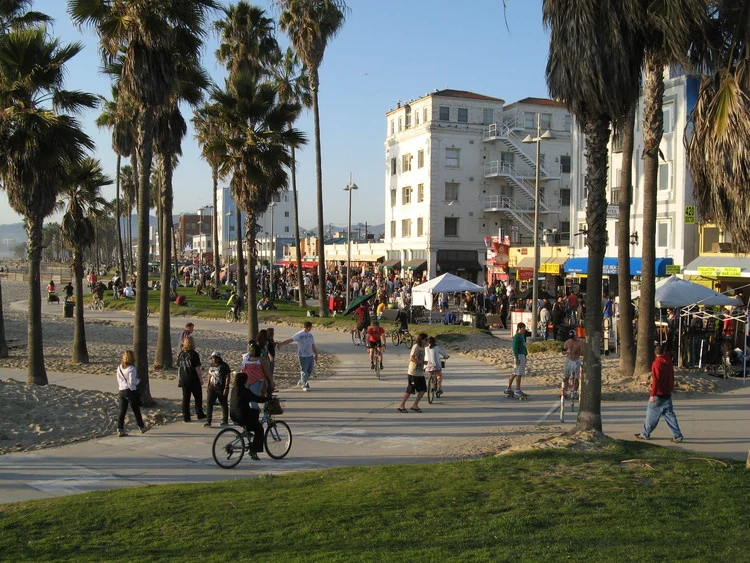Rinki Cohn proudly reports from South Africa about how the country, with just a fraction of the resources of a lot of countries, has successfully flattened its COVID-19 curve and how leaders there are really trying to do the right things.
All in Insider's Guide
Food Sharing, Barcelona Style
Some people love to share their food. Kristine Mietzner, not so much. Then a Barcelona food tour changed everything.
Hidden Philippines: Tropical Mountains Beyond and Above the Beach
There's more to the Philippines than white sandy beaches, clear blue ocean, soothing waves, and swaying palms trees. When American expat BJ Stolbov settled in the Philippines, he traveled beyond and above the tourist-laden beaches to a world of lush tropical mountains and indigenous tribal culture and people. Discover his insider tips for exploring the mountains of northern Luzon.
The Inside Scoop on Paris Museums
Writer Dorty Nowak has lived in Paris, on and off, for ten years. When friends planning a trip to the City of Lights for the first time ask her what museums they should visit, her number one choice, the Carnavalet, rarely makes the guidebook "must visit" lists. Get the inside scoop on what makes it so special.
NEW HAMPSHIRE—Presidential Primaries, Sightseeing, Skiing, and Summer Fun
by Judith Fein
When I was a child, living in New York City, my family loaded themselves and their belongings into a car every August and headed for New Hampshire. There was never any question about going somewhere else; we had allergies and Bethlehem, New Hampshire had no pollen. In a fit of hopeless nostalgia, I decided to go back this past summer, to see if I could find the locus of the sneeze-free bungalow colony where we stayed. And, being a travel addict, I decided to check out what else there is to see in New Hampshire with 10 days, a car, and a desire for culture, charm, a foodie infusion, local attractions, art, nature, and quirk.
I discovered that New Hampshire is a year-round destination: Fall foliage viewing, skiing, and Presidential primary candidate viewing that starts in the Winter, and touring and hiking in the Summer.
Street Tango in Buenos Aires
by Kate McCahill
On weekends, Alex and Vicky, my landladies, take me on walks through Barracas and San Telmo. They have known these Buenos Aires neighborhoods all their lives; they point out old buildings they’ve inhabited and the places where grand old cafés once stood. They are sisters. They’ve each been exiled twice, the first time to Europe for political reasons, the second to Mexico for economic ones. Each time, they returned because things were improving in Argentina, and they wanted to be a part of the change. They’ve rented their spare room to dozens of foreigners over the years, English teachers and language students like me.
Editor's Note: This article is part of a new series by writer-photographer Paul Ross featuring field-tested reviews of places, products and services that enhance the travel experience. All are evaluated honestly. If something is just bad, he won’t write about it. If it's really bad, or darn right dangerous, he will warn you.
Story and photos by Paul Ross
This year I decided to celebrate my birthday early in San Francisco.
As an AARP-certified senior, it’s years since I’ve been festive about my natal day and even longer since I’ve visited “Baghdad-by-the-bay” (coined in the 1940’s by San Francisco columnist Herb Caen). Growing up in Southern California, I osmotically acquired a slight sense of residual rivalry toward Frisco. We had sun, surf, sand, and they had fog, cold, and business. As an adult, I figured it was time to explore what many locals call “the City” had to offer.
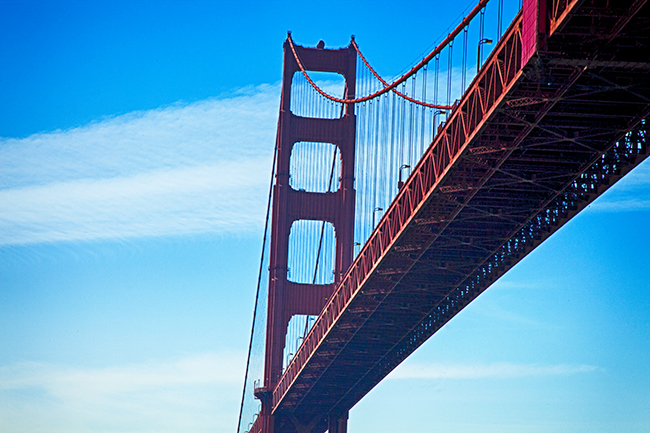 The Golden Gate Bridge. (The only ways to get this particular view are swim, jump or take a bay cruise. I recommend the last.)
The Golden Gate Bridge. (The only ways to get this particular view are swim, jump or take a bay cruise. I recommend the last.)
BAY AREA CLASSIC
I decided to start out with a Bay Area classic: the venerated Mark Hopkins hotel atop elegant Nob Hill via cable-car-carrying California Street. The hotel features a museum of the hotel’s colorful history from its Victorian era founding through its heyday housing of celebrity guests; their favorite watering hole was the Top of the Mark with its almost 360 degree view.
I was fascinated by nostalgia-laced mementos and exhibits, like a video interview with a nonagenarian who was once a nude model and photos of the big bands that had played there. “The City” preserves her majesty in ornate buildings and cable cars, one of which I rode down to Chinatown, while vowing to hike back up the really steep slope to work off Sum of my Dim dumplings.
When, on a family vacation, I first went to Chinatown as a kid, my grandfather took us all to a restaurant frequented by Danny Kaye, so of course I had a yen to go back. Located on heavily touristic Grant Avenue, the food is so tired that it could’ve been leftovers from Kaye’s days. But when I walked a few blocks from Grant to Jackson Street, I discovered Z & Y, which, despite its bland name, featured hot and spicy Szechuan delights I never dreamed of as an L.A. boy. Z&Y is on the same block as the P&R and the ABC restaurants and is as easy to find as 1,2,3.
Floating on the Ocean
by B.J. Stolbov
Pagudpud is not a promising name for a beach town.
Boracay – now that’s a great name for a beach town. Boracay is an island between the Tablas Strait and the Sibuyan Sea in the Visayan Islands of central Philippines. This is the place where people, many foreigners, go when they want to go to a beach. Here are white sandy beaches and deep blue waters, planted coconut palms and scheduled ferries, harbors for sailboats and large yachts, expensive hotels and designer resorts, gourmet restaurants and fast-food joints, beautiful women in tiny bikinis and handsome shirtless men, hot sunny days and wild drunken nights, 24-hour bars and all-night discos, music, singing, laughing, fun, affairs, romance, sex, secrets, exciting evenings, and, maybe, a regret-filled morning. Boracay.
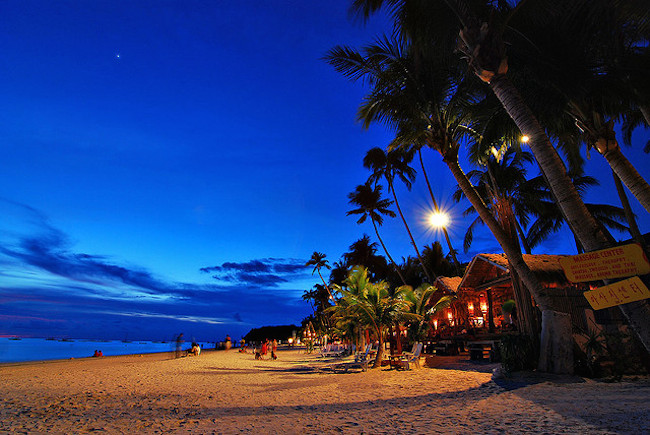 Boracay Beach at Dusk/ Flickr.com
Boracay Beach at Dusk/ Flickr.com
Pagudpud sounds like one of those small, lost towns in northern New Jersey. Pagudpud is a small, lost town in northern Ilocos Norte. It is the most northern town in the most northern province on the northern island of Luzon. From Manila, it’s a 10 to 12 hour bus trip. But when Filipinos want to get away, they go to Pagudpud.
Pagudpud is a tranquil, isolated town nestled between the South China Sea and the Cordillera Mountains. Protected by the mountains, few storms threaten up here. The weather is warm, but not hot. The ocean is clear, blue, and unpolluted. The fishermen, in their hand-built boats, are out early in the mornings, tending their nets. Long-winged seabirds fly low over the water. Wavelets splash lightly on the shore. The beaches are pristine, unspoiled, and almost all white sand. These beaches are some of the most beautiful in all of the Philippines.
A Partner Post by PerpetualExplorer.com contributor, Emma Corcoran.
Two or three times a week, Jay Savsani hosts a meal on the rooftop of his Chicago apartment complex. Last week his dinner guests were two Swiss tourists, and this week he’ll be hosting some fellow Chicagoans. Jay and his fellow diners are strangers but have connected through MealSharing.com, the food-centered social networking site Jay founded last year.
MealSharing allows diners and hosts from around the world to meet and share a home-cooked meal. Hosts put a profile on the site, which lists the types of food they usually cook and displays photos of their past culinary creations. Guests can then make contact and request a meal. MealSharing is a free platform; it costs nothing to participate as a guest or a host in this “couchsurfing for foodies” social movement.
“We come from a mission where we care about bringing communities together; be it from an international standpoint or within the local area,” says Jay, who says that “MealSharing is platform that connects travelers; however people also use it as a way to eat with other meal-sharers in their hometown.”
A Partner Post by PerpetualExplorer.com contributor, Anitha Aravind.
In Chennai, where I live, there may not be a park or shop for every street in the city, but there definitely will be a temple for Lord Ganesha, the elephant-faced God. Under a tree, outside big houses, in apartment complexes or even right in the middle of the road, these temples are small but revered. Most people begin their day or any venture with a visit to their neighborhood Ganesha temple for a glimpse of their lucky mascot.
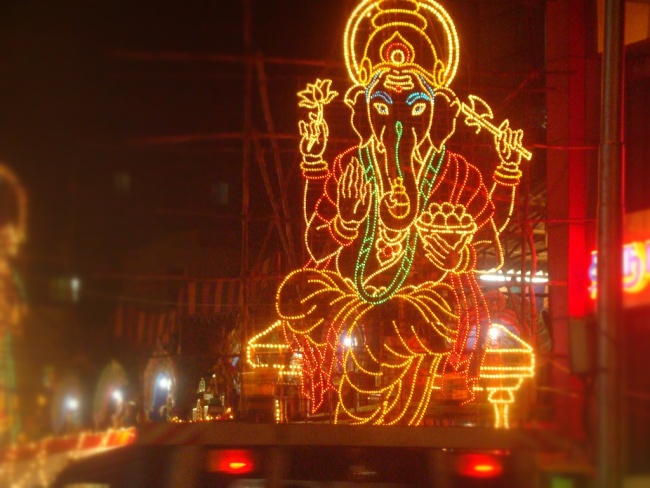 Ganesh Chathurthi in Chennai. Photo by Elizabeth Shilpa Abraham via Flickr CCL
Ganesh Chathurthi in Chennai. Photo by Elizabeth Shilpa Abraham via Flickr CCL
When it’s time to celebrate the birthday of this charming God, usually in the last week of August or the first couple of weeks in September, the entire country bursts into festivities. This festival, called Ganesh Chathurthi or Vinayaka Chathurthi, is a community affair celebrated throughout India, but nowhere is it as grand as it is in Maharashtra, specifically in Mumbai. For thousands of people in Mumbai, this festival is a main source of income.
The Story Behind Ganesh Chathurthi
There are plenty of myths associated with Ganesha, but the most interesting one is the story of his birth and how he got his elephant head. It is said that Goddess Parvathi lovingly carved out a boy out of turmeric paste that she had applied on her body. She instructed the boy to stand guard outside while she took a bath. When her husband Lord Shiva came to meet her, this boy refused to let him in. Known for his temper, Shiva ordered his force to attack the boy, but they failed in their attempt. Then Shiva himself attacked and beheaded this boy.
Shoots, Edits & Posts
by Jules Older
Shooting travel videos was always something other people did.
For one thing, I'm a word guy, a writer. Visuals are for somebody else.
But that’s hardly the only reason I shied away from shooting. There's my profound lack of knowledge about how to make movies. The teamwork required to do it. The weight and expense of even a secondhand, third-rate movie camera. Plus the knowhow and expense of editing footage once it’s shot.
And all that was once true. Now it isn't. Welcome to one of the true wonders of the Digital Age. I'm still a writer, but now I'm a writer who shoots videos. More than sixty of them and counting. Maori carving in New Zealand. Skiing in Alberta. An action-sport competition in San Francisco. Turns out I like visual story telling, too.
But the main differences between then and now are technological. Thanks to advances in gear, I (and you) can learn to shoot, buy the gear and even master the editing process without going broke or going crazy.
I've learned my craft at the Apple Store, using their One to One program, which, when you buy a new computer, is yours for $200 for two full years. No further charges required. No tips accepted.
by Jules Older
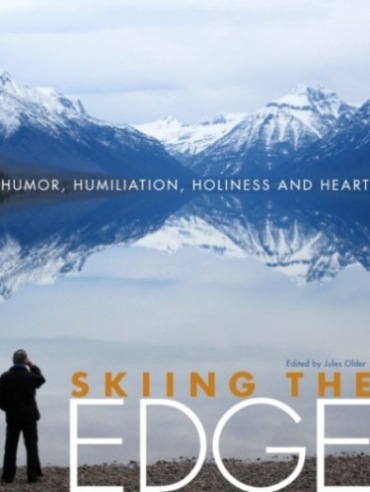 Sometimes a great notion comes in unexpected form.
Sometimes a great notion comes in unexpected form.
In this case, it was an email — a deeply humiliated email — from a travel and ski writer. He'd just spent a night in the drunk-tank in the ski town of Whistler, British Columbia. Here's how the email started:
“For accommodations in Whistler, you can’t beat the price. I found a single room for the cost of a bottle of Chianti (Reserva 2007 - $24.95, plus tax).”
The moment I read that opening line, I wanted to publish the email as a ski story.
The moment I had that thought, I had another: I can publish it as a ski story.
And before the sun set, I’d begun the process of publishing my first and, so far, only, ebook.
Ebook: a book-length publication in digital form, to be read on ebook readers, mobile devices and home computers.
I emailed the best ski writers I knew who wrote personal stories — not instructional, race coverage or gear reviews — and asked them to contribute one chapter each to an ebook with, as yet, no ename.
And while I awaited their answers, I created a name:
SKIING THE EDGE: Humor, Humiliation, Holiness and Hope.
Almost all the writers said yes. They sent me deeply personal tales from an altitude of 17,000 feet in Bolivia, from dodging gunfire on the slopes of Lebanon, from the day the chairlift crashed in British Columbia. They sent stories from the interrogation room in Toronto’s airport, from a sickeningly steep couloir in France, from the little ski town in Colorado where Beth Jahnigen first encountered real male culture:
SKIING THE EDGE: Humor, Humiliation, Holiness and Heart is my first eBook, and the learning curve has been as steep as a double-black-diamond run at Vail.
by Jules Older
For travelers, some things are essential. Others should be left at home or not acquired in the first place. Here’s this year’s compilation of things you need and one thing you don’t.
The outdoors maxim, “Take nothing but pictures; leave nothing but footprints,” is where we’ll start.
TRAVEL ESSENTIAL #1
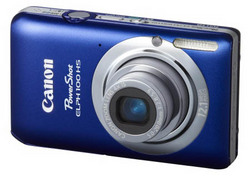 If you're gonna take pictures, I've got a camera for you. It’s small enough to stick in your pocket, light enough to take on a mountain climb, cheap enough to let you pay your mortgage … and powerful enough to blow you away. It blew me away, and I'm used to great cameras in small packages.
If you're gonna take pictures, I've got a camera for you. It’s small enough to stick in your pocket, light enough to take on a mountain climb, cheap enough to let you pay your mortgage … and powerful enough to blow you away. It blew me away, and I'm used to great cameras in small packages.
The camera in question is the Canon PowerShot ELPH 100 HS. It weighs less than five ounces, fits in a shirt pocket, and costs less than $200. But its real strength lies in what it can do.
Video? Full hi-def. Sound? Impossibly good — doubly so for a camera with such a tiny microphone. Low-light capability? Still can't believe what I've captured in gloomy rooms. Zoom lens? Big zoom but loses sharpness when you really pull in that distant egret. Viewfinder? No, but you'd better get used to that. Like the typewriter or phonograph, the viewfinder is a dying species.
After testing the 100 HS on snow and off, in two hemispheres, I pronounce it the best small camera I've ever tried. And the best buy. www.canon.com
TRAVEL ESSENTIAL #2
From pictures to footprints. I've been testing two shoes — one made for walking and one for running. My first question: Does that designation really make a difference?
Montana on my mind
by Jules Older
When I teach skiing, I suggest to my students that, to establish and hold a rhythm, they find their ski song.
Truth is, my ski songs find me. My usual one is Sweet Georgia Brown. When I skied West Virginia, it morphed into Miner’s Lifeguard. When I crossed from Switzerland’s French side to the German, my song suddenly switched to Springtime for Hitler and Germany.
See? My song finds me.
Becoming A Fan
by Dorty Nowak
Hot and frustrated, I stared at the pieces of the supposedly easy-to-assemble electric fan that came with nine parts instead of the required ten. My apartment, like most buildings in Paris, has no air conditioning and, after several days of unremitting heat, I was desperate. I picked up the instruction sheet, ignoring the number for the help center that was probably located in China, and folded it into a fan. My makeshift fan worked surprisingly well, reminding me of a museum that I had been meaning to visit ever since I read several years ago that it might have to close.
by Jules Older
I'm a travel writer and videographer. I fly to New Zealand, drive to San Jose, train to Banff, ferry San Francisco Bay. I've come to know what travelers need and what they're better off without.
So here's my list: what to buy and one thing to avoid. Here we go…

 Clic reading glasses. They've gone up in price from about $30 to just under $80 (or $24.99 at The Trip Shop), but they're still savers of time and space. One pair of Clics replaces, in my case, a dozen reading glasses, one in every room of the house, one in the car and one in the place I put them where I'd never forget them and then forgot them. Clics, which you can buy online, just hang around your neck waiting to be magnetically clicked into action. I never travel without ‘em. And I no longer use strong language when searching for my accursed glasses. www.clicgoggles.com
Clic reading glasses. They've gone up in price from about $30 to just under $80 (or $24.99 at The Trip Shop), but they're still savers of time and space. One pair of Clics replaces, in my case, a dozen reading glasses, one in every room of the house, one in the car and one in the place I put them where I'd never forget them and then forgot them. Clics, which you can buy online, just hang around your neck waiting to be magnetically clicked into action. I never travel without ‘em. And I no longer use strong language when searching for my accursed glasses. www.clicgoggles.com

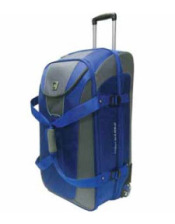 High Sierra luggage. First rule of suitcase: It’s gotta have sturdy wheels. Second: Must be as light as possible. Third: Has to hold everything you need. If, like me, you're a skier, that means a lot of holding. Between boots, helmet, gloves, parka and ski pants, we don’t travel light.
High Sierra luggage. First rule of suitcase: It’s gotta have sturdy wheels. Second: Must be as light as possible. Third: Has to hold everything you need. If, like me, you're a skier, that means a lot of holding. Between boots, helmet, gloves, parka and ski pants, we don’t travel light.
One bag that meets all these requirements is the High Sierra 32” A.T.GO expandable, wheeled duffel. It’s big enough to hold everything, thus avoiding airline extra-bag charges. It’s light enough to save your back and avoid airline extra-weight charges. Sturdy zipper, strong wheels, good balance. If you pack big, you'll be glad you got it. And though it retails for $340, The Trip Shop (powered by Amazon) has it at $126. www.highsierrasport.com

Salomon shoes. Start with this: For any footwear — hiking boots, running shoes, ski boots, sandals — fit is 10 times more important than brand. If they don’t fit in the store, when you get to the trail, the track, the mountain or the beach, expect a world of pain.
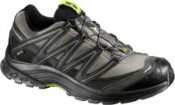 That said, if they do fit (and they fit me better than any other brand) Salomon athletic shoes are your best bet. That’s because Salomon came up with QUICKLACE — where one pull replaces tying and retying laces. It’s Lacing for the Lazy. Like me.
That said, if they do fit (and they fit me better than any other brand) Salomon athletic shoes are your best bet. That’s because Salomon came up with QUICKLACE — where one pull replaces tying and retying laces. It’s Lacing for the Lazy. Like me.
Ah, but which model: the XA Comp 3 or Wings? The XA Comp 3 is a bit lighter, 350 grams, and somewhat cheaper, about $100. Wings has more padding, which means more protection from pavement. It also means more weight, 390 grams, and more moolah, $130-160. www.salomon.com/us
by Ellen Barone
[this is the final article in our SPOTLIGHT ON PORTUGAL series this week... ]
When the only vices of a place involve food and wine, booking a flight is a no-brainer according to my travel rules. Throw in sandy beaches, cultural riches, mild climate, a lost-in-time pace of life, and an inexpensive cost of living, and you won me over, Portugal.
On a recent visit to the northern wine country, I spent four delicious days table-hopping from hearty lunches, rustic meals featuring unpretentious fare and artisanal feasts prepared by innovative young chefs who bring a creative flare to traditional specialties. Each meal was paired with the region’s fresh, light, aromatic wines known collectively as Vinho Verdes.
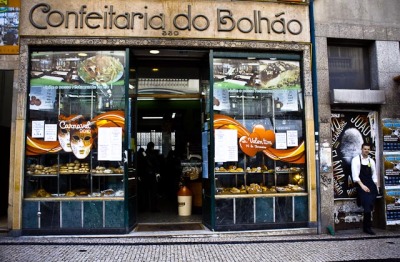 In Porto, the Confeitaria do Bolháo (Rua Formosa 339) proves it doesn’t have to be expensive to be good. I’d wandered into the café for an espresso and to sit out an afternoon rain shower. But I quickly upgraded my order to the meal of choice among the elderly patrons in wool caps and sturdy shoes who packed the place. “Yes, it’s fantastic”, said the waiter, when I asked to have what the couple at the table beside me were so obviously enjoying – a plentiful plate of crispy sardines, crusty bread, a delicious stew of red beans and rice and a carafe of robust red wine. Total bill: 7-euros. Nice.
In Porto, the Confeitaria do Bolháo (Rua Formosa 339) proves it doesn’t have to be expensive to be good. I’d wandered into the café for an espresso and to sit out an afternoon rain shower. But I quickly upgraded my order to the meal of choice among the elderly patrons in wool caps and sturdy shoes who packed the place. “Yes, it’s fantastic”, said the waiter, when I asked to have what the couple at the table beside me were so obviously enjoying – a plentiful plate of crispy sardines, crusty bread, a delicious stew of red beans and rice and a carafe of robust red wine. Total bill: 7-euros. Nice.
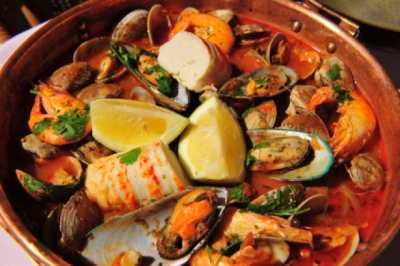 A perfect example of the region’s rustic fare is Restaurante Páteo das Figueiras (Rua do Além 257), a homey establishment near Braga which serves exquisite local cuisine family-style in a simple and cozy room. The caldierada, a stew consisting of a variety of fish and shellfish with potatoes, tomato and onion, scooped up with a garlicky bread, was delicious.
A perfect example of the region’s rustic fare is Restaurante Páteo das Figueiras (Rua do Além 257), a homey establishment near Braga which serves exquisite local cuisine family-style in a simple and cozy room. The caldierada, a stew consisting of a variety of fish and shellfish with potatoes, tomato and onion, scooped up with a garlicky bread, was delicious.
by Judith Fein
[more from our SPOTLIGHT ON PORTUGAL series this week... ]
 photo by erin-thérèse via flickr (common license)Do you believe in miracles? How else can you account for what happened in a field in central Portugal on May 13, 1917, when three shepherd children saw a vision of the Virgin Mary? Purportedly, she told the awe-struck kids that she would appear at the same spot on the l3th of the five following consecutive months. According to believers, up to 70,000 witnesses beheld a miraculous apparition on the 13th day of the last month. Go to Fatima yourself to see if you are uplifted, transported, or merely interested. It’s about one and a half hours from Lisbon by train. The three children are buried in the sanctuary, and in one outdoor area the faithful light long beeswax candles that intertwine as they melt and carry prayers to heaven. Be sure to visit the museum, where Marians from around the world—including Pope John Paul—have left objects that are precious and significant to them. The latter even donated the bullet that was used by the man who tried to assassinate him. He believed that the Virgin of Fatima saved him.
photo by erin-thérèse via flickr (common license)Do you believe in miracles? How else can you account for what happened in a field in central Portugal on May 13, 1917, when three shepherd children saw a vision of the Virgin Mary? Purportedly, she told the awe-struck kids that she would appear at the same spot on the l3th of the five following consecutive months. According to believers, up to 70,000 witnesses beheld a miraculous apparition on the 13th day of the last month. Go to Fatima yourself to see if you are uplifted, transported, or merely interested. It’s about one and a half hours from Lisbon by train. The three children are buried in the sanctuary, and in one outdoor area the faithful light long beeswax candles that intertwine as they melt and carry prayers to heaven. Be sure to visit the museum, where Marians from around the world—including Pope John Paul—have left objects that are precious and significant to them. The latter even donated the bullet that was used by the man who tried to assassinate him. He believed that the Virgin of Fatima saved him.
Perhaps, while you’re in Portugal, you’ll want to find out about the secret Jews in the mountains of central Portugal who were forcibly converted to Catholicism during the Inquisition. After half a millennium of hiding their identity, they finally came out. In Belmonte, where a museum tells the story and shows the artifacts, you’ll be swept into a world where people clung to their religion in the face of great danger and, in the end, faith triumphed over oppression. There is also a synagogue, and you may be fortunate enough to meet some of the Belmonte Jews. When they decided to publicly claim their heritage and faith—about twenty years ago-- the story captivated people round the world, and now Belmonte is one of the top stops in the region for visitors of all religions.
Newfoundland: Three Lifetimes in Three Days
by Jules Older
I'm a travel writer, which means I'm a hit-and-run artist — New Zealand’s North Island today, the southern Sierra tomorrow. I'm the man who rarely returns.
Except to Newfoundland. I've been five times to Canada's easternmost, poorest and most interesting province. That chunk of rock in the North Atlantic, closer to Ireland than to Vancouver, 1,600 miles east of New York, captured my heart an hour into my first visit.
On the latest visit, I experienced three lifetime thrills in three consecutive days. Where else on earth can you do that?
THRILL ONE: ICEBERGS
It began in the tiny town of Springdale, where we hooked up with ace pilot Rick Adams, owner-operator of Springdale Aviation Ltd.
I flew over and around massive icebergs making their way south from Greenland. Never before had I seen a berg, and now they were scant yards below the Cessna 185's wing.
But if iceberging from a low-flying plane is a thrill, berging from a sea kayak is a life event. Because sea kayaking has a very steep learning curve -- you can be moderately proficient in an hour or so -- and because icebergs have a tendency to get stuck just offshore in the province's protected harbors, the experience is open to the many rather than the fit few.
It's a stunning experience. I drove over a hill and down into an outport, Newfoundland for coastal village. My heart thumped a little louder as I spotted the gleaming white of half a dozen icebergs towering above the dark water like dollops of cream on a chocolate cake. I couldn't wait to haul the kayak off the roof of the van.
Hidden Venice Beach: A Walking Tour
Someone once wrote that if you tip the United States on edge, everything that’s loose will slide down to Los Angeles. I would add, if you tipped Los Angeles on edge, it will all slide down to Venice Beach.
Few visitors stray far from the boardwalk. Those who don’t miss the best show of all -- the other attractions that make Venice Beach the largest spontaneous outdoor theme park/playground and one of the most interesting communities in the world. To discover the hidden highlights of Venice Beach, just follow this easy, leisurely walking tour. It should take about three hours or more if you want to shop, linger, and eat, or less than three if you are in a hurry.












